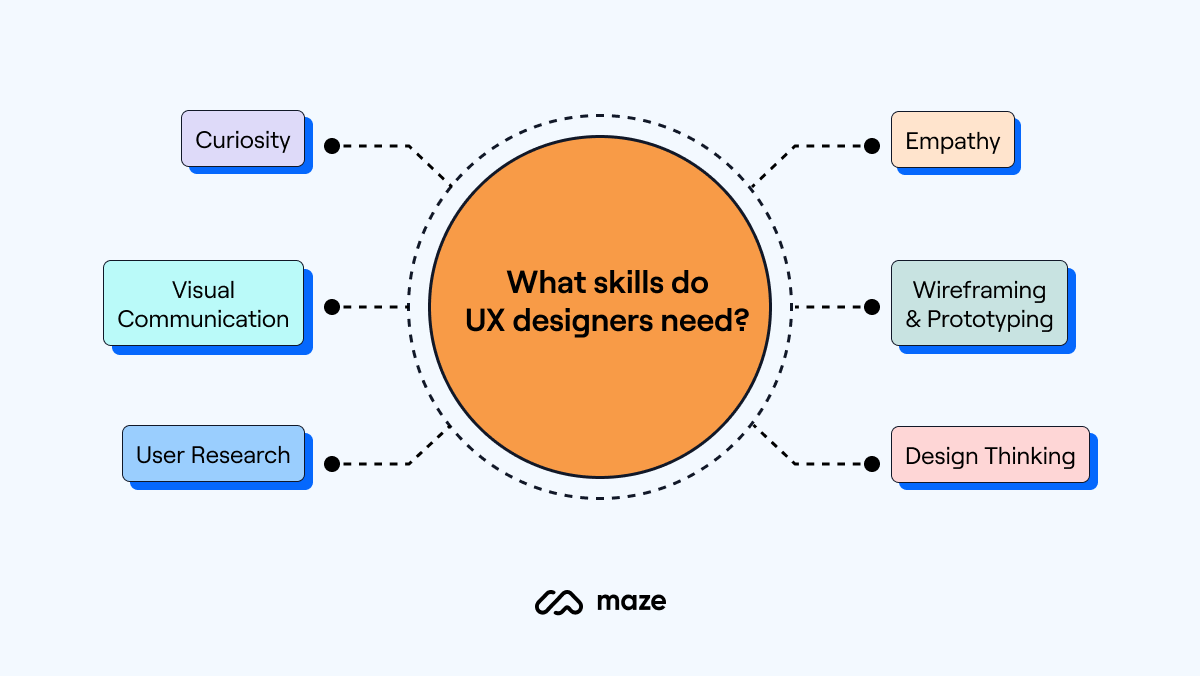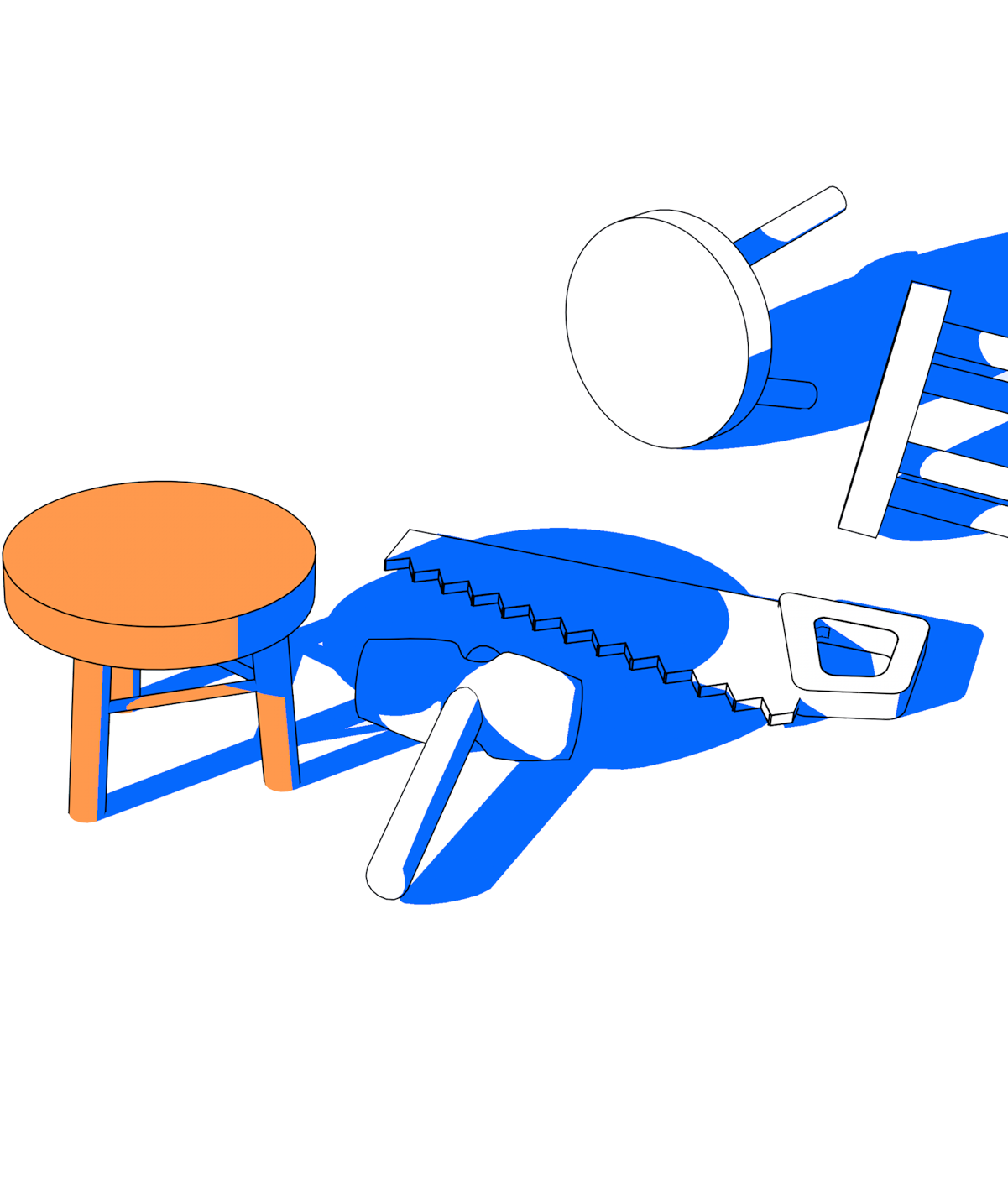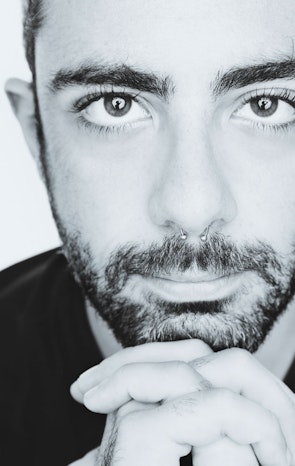User experience (UX) design is often mixed up with user interface (UI) design. Although the two work closely together, they are different. This article will give you a run-down on everything you need to know about UX design, from a UX designer’s business functions to useful tools and resources to become a better UX designer.
We spoke with Fabio Rose, UX Engineer and UX professor, and Hazel Watts, UX Content Specialist, to support this article and share some industry insights from those in the thick of the game.
Whether you’re looking to get into the UX design industry, understand the role of UX design better, or even hire a UX designer, this article is for you.
What is user experience design?
User experience (UX) is the relationship between a product and the person using it. UX design focuses on building products that someone can easily use and enjoy using.
“User experience design is about supporting user’s needs, but making sure not to distract them from the overall experience of the product.
The story you’re telling about a product should speak exactly to the intended audience with no unnecessary jargon or imagery.
There is definitely a sweet spot between supporting the process and overcomplicating it! Research, trying, testing, iterating, and testing again. That’s UX design—your job is never done. The story you’re presenting is always developing along with your products.” — Hazel Watts, UX Content Specialist.
What does a UX designer do?
A user experience (UX) designer makes sure a product is learnable and usable for the end-user. A UX designer works from the very beginning of any product process to ensure product teams are building products that are conscious of their users, their needs, and pain points.
A UX designer works with branding, navigation, content, and product functions to ensure all of these elements are tied together to create an end result that’s joyful and fluid.
UX designers are responsible for more than just the product experience and product lifecycle—they’re key players in the entire customer lifecycle.
The decisions a UX designer makes influences if a user is attracted to, willing to pay for, and can use a product in the first place. Updates and tweaks a UX designer makes to a live product can positively affect customer retention rates and customer lifetime value (CLTV).
Tip
Maze Customer Success Lead, George Markos, gives an inside look at our Customer Advisory Board and the benefits of regularly involving customers throughout the product development process.
What’s the difference between a UX and a UI designer?
UI design is a little different because it focuses on human-computer interaction. This can be anything from a desktop web page to the usability of an app screen on a handheld device.
User interface designers (also known as interaction designers) focus solely on the interface of a product, not the flow between interfaces or the user’s experience going through the journey.
User interface design works closely with user experience design. Together, UX and UI designers conduct user research, measure usability, and are constantly testing designs for any stand-out success to replicate or error to fix.
A UI designer usually has some kind of understanding of front-end development and graphic design. They focus on visual assets, while a UX designer will focus on all parts of the user experience.
Discover how to measure the success and progress of your UX activities with these essential UX KPIs.
What skills do UX designers need?

Let’s break this section into two parts; hard skills and soft skills needed in UX design.
There are certain practical skill sets a designer needs to learn to become a UX designer. At the same time, a UX designer needs to practice certain soft skills to become a successful UX designer.
Hard skills UX designers need
You need quite a few hard skills to earn the title of UX designer. Most of these skill sets you will learn in a UX design course or degree.
- UX Research
- Wireframing & prototyping
- Visual communication
- Interactive design
- Design thinking
- User flows
- Interaction design
- Testing designs
- Decision mapping
- Information architecture
- Mood boarding
- Visual & UI design
- Coding—up for debate, more on this later
It’s not easy to conquer all of these UX design skills, and it’s certainly not easy to become an expert in all of them. UX design courses—linked later in this piece—tend to have you specialize in a few specific areas of design and give you the basics of all the above.
Discover how to ask the right user research questions to get valuable insights and make better design decisions.
Soft skills UX designers need
To help us answer this question, we spoke to UX Engineer, Fabio Rose, to get a better idea of some of the soft skills a UX designer needs to succeed in the industry.
“For me, there are three core soft skills every UX designer needs.
1. Empathy: UX design leads with users in mind. You’ll need to investigate and completely understand the motivations, anxieties, needs, and problems of the people who will use your design. If you want the result to be functional and meaningful, it needs to be built with empathy. Forget about yourself. Listen to and understand what your users want.
Forget about yourself. Listen to and understand what your users want.

Fabio Rose
UX Engineer
Share
2. Organization: UX design is like a puzzle. You can’t miss a single piece of research if you want it to be complete. Put all of those (user research) pieces together in a way that makes the most sense for the goal of the product, and you’ll have a successful design. Good organization is essential to get you there.
3. Curiosity: UX designers need to stay curious. If you want to discover that last piece to your UX design puzzle that ties everything together in harmony, a certain amount of curiosity is needed. This means you need to be comfortable in challenging assumptions and looking for alternative solutions to those that seem the most logical.” — Fabio Rose, UX Engineer.
UX Content Specialist Hazel Watts agrees: “Empathy is the number one skill all UX designers need. The people whom you are designing for are human beings. They aren’t ‘Product Managers’ ‘Entrepreneurs’ or ‘CEOs,’ they are busy mothers, daughters, sons, and fathers.
They have deadlines, fears, money worries, and time is precious for all of them. How is what you are designing going to support them first, and then persuade them to engage with your product?”
The people whom you are designing for are human beings. They aren’t ‘Product Managers’ ‘Entrepreneurs’ or ‘CEOs,’ they are busy mothers, daughters, sons, and fathers.

Hazel Watts
UX Content Specialist
Share
Soft and hard skills aside, there’s one area of UX design that remains unclear to many, and that’s code. Ready to get it answered?
Do user experience designers need to code?
In short, no. User experience designers don’t need to code, although it’s definitely a nice skill to have.
Even if a UX designer doesn’t code themselves, they’ll be working with engineers and developers that code for them, so it’s useful to understand coding capabilities.
By speaking the language, designers can better translate the feasibility of a user experience design concept.
Most user experience designers have basic knowledge of HTML, CSS, and Javascript. Although, they haven’t necessarily learned it to become a UX designer, more so because of past experience or because they want to collaborate better with their engineering colleagues.
Today, we’re seeing more and more SaaS models popping up to support ‘no-code,’ or ‘low-code’ user experience design methods, so the demand for coding expertise in UX design jobs is thinning out.
Which types of projects are UX designers involved in?
UX designers are often asked to contribute towards business development projects that are not traditionally within a designer’s scope of work. This is largely because they often provide a unique, empathetic lens that other core business roles don’t tend to focus on.
Let’s explore some of the projects you could (and should) involve a UX designer in.
Customer retention
UX designers can provide a unique input when it comes to customer retention. They often have specific data sets that can pinpoint problem areas that need improvement and can help retain customers by reducing these friction points.
Specifically, user experience designers can help with:
- App design
- Product design
Lead Generation
Any lead generation project should include a UX designer’s input. Whether that’s qualitative input and guidance, or the actual design of a lead gen flow, user experience designers can give your generation machine the best chance possible at success.
A few lead generation methods to include a UX designer in are:
- Landing pages
- Email flows
- Website design
- Blogs, Guides & Case Studies
- User Research
Internal processes and systems
Lastly, user experience designers can go beyond your customers, users, product, or service. They can also help towards strategies that help keep employees happy and retain staff.
By using a combination of soft and hard skills, user experience designers can offer support, guidance, and technical design solutions when it comes to building new processes, systems, and communication methods.
6 tools for UX designers
No matter how long you’ve been in the business, there will always be user experience design tools to help you get your work done more efficiently and accurately. We share a more detailed look at the top user experience design tools in another article. However, a few well-known favorites are:
- Figma: a collaborative, web-based, vector graphic edit and interface design tool
- Adobe XD: a vector-based experience design platform
- Maze: a rapid user-testing platform for user experience prototypes—gathering user feedback from real humans
- Sketch: a collaborative digital design app for Mac
- InVision: a digital product design platform
- Webflow: a no-code, visual canvas website builder.
Learn how the UX team at Vanquis Bank brought user insights to the table by introducing Maze to their tool stack.
How to become a user experience designer
If you’re seriously considering becoming a user experience designer, follow these five steps to help you get there as quickly as possible.
1. Brush up on UX principles
There are a few design principles every UX designer needs to lead and learn with if they want to be successful in their role.
UX design principles are things like hierarchy in information architecture, design consistency in branding, and accessibility. There’s a lot more out there, and these are your first steps into the UX world.
2. Do a UX design course
Studying UX design at university or via an online course is a great way to kickstart your design career.
There are some excellent UX design universities and colleges out there; Google search results are flooded with results—most of them offer online options as well. Here's a few of them:
- SuperHi: Intro to UX Design
- Skillshare: Fundamentals of Usability
- Interaction Design Org: The Beginner’s UX Guide
- Career Foundry: Become a UX Designer
- Design Lab: UX Academy
- IronHack: UX/UI Bootcamp
- Coursera: UI/UX Design Specialization
- Barcelona Code School: UX Bootcamp
- All Women Academy: UX Design (Part-time)
3. Take on an internship or UX projects
Next up, it’s time to put your skills to the test. It’s time to make mistakes, fail, and learn quickly. This step is best with freelance design tasks or an internship where you receive mentorship or management support.
It’s worth noting you can do this after you’ve finished your studies or can take something on alongside your studies and apply what you learn as you go.
4. Build your portfolio
As you take on more design projects and internships, you’ll naturally start to build your design portfolio.
This is not only a place to keep track of your work, but it’s your CV for future employment. Keep in mind the hiring manager’s experience when looking over your portfolio. They’re not only looking at your work experience, but they’re also looking at your overall presentation of your portfolio—it gives another level of insight into your UX talent and knowledge.
5. Build your UX network
Lastly, it’s time to get yourself out there. Make sure you’re following inspiring user experience designers, UX leaders, and leading brands on social media. They often share articles and useful things UX designers should know. Here are a few of our favorites:
- Twohabitsdesign
- Iamnotmypixels
- Dailywebdesign
- Humble_ux
- Steve Krug
- Don Norman
- Irene Au
- Jessicavwalsh
- Uitrends
- Taylor Ling
At the same time, consider building your social presence, showcasing your work, and getting your name out there too. Social media doesn’t just mean Instagram, there are plenty of opportunities to connect on Twitter, showcase your work, share articles, and there are some great Slack design communities out there too.
Your online network within the design community is a handshake away from your next design role interview.
Every journey into the world of UX is different. Some people purposefully study to become a UX designer, while others slowly begin to lean into UX after working in other roles within product and marketing. Let’s take a look at how Fabio and Hazel started their UX journey.
“10+ years ago, I completed a master’s in digital marketing, Universidad Autónoma de Barcelona, finishing with a specialization in UX.
Since then, I realized how important it is to focus on design when creating any piece of digital content. I still work for the same University, conducting UX exercises with current students.
While this UX field has been in development since the ’90s, with some super smart badass guys working in the best companies at the time (Apple or IBM)—like Don Norman and Jacob Nielsen—it’s only recently reaching the vast majority of companies and being understood.
After this discovery period is over, the pathway for a future in UX design is going to be a brilliant one for empathetic, organized, and creative minds.” —Fabio Rose, UX Engineer.
“I pivoted into product from video production. Having worked for many tech companies, I was always telling interesting product stories but never knew how I could be part of creating the products themselves.
Giving my time to a few startups and participating in hackathons, I realized that my skills could be transferred into product. I then took a 10-week boot camp in product management at the AllWomen Academy in Barcelona, a course for women by women.
Not only was it a great crash course in product management, but I also got to build a fantastic network and now regularly attend interesting events. Women are still a minority in tech, but being part of the step in the right direction is really rewarding, and I hope to pass my learnings on to others in the future.” —Hazel Watts, UX Content Specialist.
Wrapping up
Whether you're building a digital product or showcasing a service, you'll need some talented user interface designers and user experience designers on your product team from day one.
No matter what you're building, the end-users are human users, and it's the designers' prerogative to lead with that notion in mind.
UX design is all about the experience. If you’re not building a positive product and brand experience for your customers, you’re not building a business. Your end-user needs to be your first user, and you can do this by hypothesizing, testing, and building people-conscious products from day one.
Hopefully, this article has shed light on the world of UX design and what it can potentially offer your business. You can read more on UX design here.



